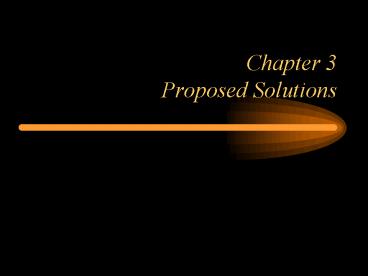Chapter 3 Proposed Solutions - PowerPoint PPT Presentation
Title:
Chapter 3 Proposed Solutions
Description:
The High-Speed Rail Office received 5 very different proposals to finance, build, and operate a high-speed rail system linking Orlando, Tampa, and Miami. ... – PowerPoint PPT presentation
Number of Views:43
Avg rating:3.0/5.0
Title: Chapter 3 Proposed Solutions
1
Chapter 3Proposed Solutions
2
Learning Objectives
- Second phase starts when the RFP becomes
available and ends when an agreement is reached
with a contractor - Proposal marketing strategies
- Bid/no-bid decision
- Development of a winning proposal
- proposal preparation process and elements that
may be included in a proposal - pricing considerations
- the evaluation of proposals
- types of contracts between the customer and the
contractor
2
3
Proposed Solutions
- In many situations an RFP does not involve
soliciting competitive proposals from external
contractors, and the second phase of the project
life cycle may be completely bypassed.
3
4
Real-World Example
- The Florida Department of Transportation
- The High-Speed Rail Office received 5 very
different proposals to finance, build, and
operate a high-speed rail system linking Orlando,
Tampa, and Miami. - Three steel-wheel and two magnetic levitation
proposals - estimated cost from 740 million to 5 billion
- average trip time from Miami to Orlando ranged
from 49 minutes to 2 1/2 hours - projected number of riders varied from 6 million
to 30 million
4
5
Pre-RFP/Proposal Marketing
- Should not wait until formal RFP solicitations
are announced before starting to develop
proposals - Develop relationships with potential customers
- Maintain frequent contacts with past and current
customers
5
6
Pre-RFP/Proposal Marketing (Cont.)
- Be familiar with a customers needs and
requirements - Consider this marketing or business development
no cost to the customer - May prepare an unsolicited proposal
- Efforts are crucial to the foundation for winning
a contract
6
7
Bid/No-Bid Decision
- Factors to consider
- competition
- risk
- mission
- extension of capabilities
- reputation
- customer funds
- proposal resources
- project resources
7
8
Bid/No-Bid Decision (Cont.)
- Be realistic about probability of winning the
contract - A lot of non-winning proposals can hurt a
contractors reputation
8
9
Developing a Winning Proposal
- A selling document not a technical report
- Convince the customer that you are the best one
to solve the problem - Highlight the unique factors that differentiate
you from competing contractors - Emphasize the benefits to the customer
- Write in a simple, concise manner
- Address requirements as laid out in the RFP
- Be realistic in scope, cost, and schedule
9
10
Proposal Preparation
- Can be a straightforward task performed by one
person or a resource-intensive effort requiring a
team - May designate a proposal manager
- Schedule must allow time for review and approval
by management - Can be a few pages or hundreds of pages
- Customers do not pay contractors to prepare
proposals
10
11
Proposal Contents
- Proposals are organized into three sections
- Technical Section
- understanding of the problem
- proposed approach or solution
- benefits to the customer
11
12
Proposal Contents (Cont.)
- Management Section
- description of work tasks
- deliverables
- project schedule
- project organization
- related experience
- equipment and facilities
12
13
Proposal Contents (Cont.)
- Cost Section
- labor
- materials
- subcontractors and consultants
- equipment and facilities rental
- travel
- documentation
- overhead
- escalation
- contingency or management reserve
- fee or profit
13
14
Pricing Considerations
- Be careful not to overprice or underprice the
proposed project - Consider
- reliability of the cost estimates
- risk
- value of the project to the contractor
- customers budget
- competition
14
15
Proposal Submission and Follow-Up
- Submit proposals on time
- Hand deliver expensive proposals or send 2 sets
by different express mail services - Continue to be proactive even after submission
15
16
Customer Evaluation of Proposals
- Some look at the prices and select only from the
three lowest-priced proposals - Some screen out prices above budget or whose
technical section doesnt meet all the
requirements - Some create a proposal review team that uses a
scorecard - May submit a best and final offer (BAFO)
16
17
Customer Evaluation of Proposals (Cont.)
- Criteria that might be used in evaluating
- compliance with SOW
- understanding of the problem or need
- soundness of the proposed approach
- contractors experience and past success
- experience of key individuals
- management capability
- realism of the schedule
- price reasonableness, realism, and completeness
17
18
Types of Contracts
- A contract is
- A vehicle for establishing customer-contractor
communications and arriving at a mutual
understanding and clear expectations - An agreement between the contractor, who agrees
to provide a product or service, and the
customer, who agrees to pay - Must clearly spell out the deliverables
- Two types of contracts fixed price and cost
reimbursement
18
19
Types of Contracts (Cont.)
- Fixed-price contract
- Price remains fixed unless the customer and
contractor agree - Provides low risk for the customer
- Provides high risk for the contractor
- Is most appropriate for projects that are well
defined and entail little risk
19
20
Types of Contracts (Cont.)
- Cost-reimbursement contract
- Provides high risk for the customer
- Provides low risk for the contractor
- Is most appropriate for projects that involve
risk - Customer usually requires that the contractor
regularly compare actual expenditures with the
proposed budget and reforecast cost-at-completion
20
21
Contract Provisions
- Miscellaneous provisions that may be included in
project contracts - Misrepresentation of costs
- Notice of cost overruns or schedule delays
- Approval of subcontractor
- Customer-furnished equipment or information
- Patents
21
22
Contract Provisions (Cont.)
- Disclosure of proprietary information
- International considerations
- Termination
- Terms of payment
- Bonus/penalty payments
- Changes
22































